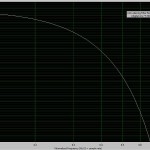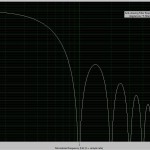Facilities
EEG lab

The EEG lab (room K.13) allows for conducting EEG experiments. The lab provides EEG equipment in the test room, and a stimulus PC and a data acquisition PC in the control room.
Relevant how-tos
Relevant how-tos are linked here.
Technical specs
Test room
- Approx. 10 m2 with a window allowing daylight to come in
- A pan-tilt-zoom camera allows capturing the participant’s activity in the room
- Table for debriefing the participant
- Participant desk and adjustable chair (up/down)
- Sink to wash electrodes
Biosemi Analog-To-Digital (AD) boxes
- For recording cortical responses or electroencephalography (EEG)
- serial: ADC 16-11-803
- Compatible with pin or flat-type active electrodes
- ‘Active electrodes’ entails that signal amplification occurs very near the recording site (minimal inference)
- Amplification is via direct current coupling (DC coupling)
- Both type of electrodes have a build-in high-pass filter (this is needed to prevent aliasing)
- fifth-order filter that is -3 dB at 1/5th of sample-rate (e.g. 3.3kHz at 16kHz sample rate or speedmode 7/9)
- LSB for standard electrodes is 31.25 nV (1/32th microvolt)
- Special for recording auditory-brainstem Responses (ABR) or frequency-following response (FFR)
- serial: ADC 17-14-1114
- Amplification is via alternating-current coupling (AC coupling; still uses the battery)
- From the Biosemi website: “In the ABR setup, the difference between a pair of electrodes is digitized after (high gain) AC amplification, whereas with the standard electrodes the voltage with respect to CMS is digitized after (low gain) DC amplification (and the difference between channels is calculated in software).“
- Needs to be operated in speedmode 9 (ABR mode)
- Requires the use of special flat-type active electrodes that have less noise but have–in addition the the low pass mentioned earlier–
- This filter is an high-pass filter in the electrode amp stage (first-order filter which is -3 dB at 100 Hz)
- AC input range 8 mV peak-to-peak (AC amplification)
- DC input range ± 250 millivolt
- noise over the the full bandwidth less than 4 microvolt peak-to-peak
- CMRR > 150 dB
- LSB for ABR electrodes is 488 pV (1/2048th microvolt)
|
AD-box switch
|
Sample-rate
|
Pin channels + EX channels + Sensor channels
|
|
0
|
Daisy-chain mode:In speedmode 0 to 3, the AD-boxes work as up to 4 optical fiber ‘daisy chained’ boxes, each with a maximum of 128+8 channels+sensors @ 2 kHz, speedmode switch = box number. (0=Box1, 1=Box2, 2=Box3, 3=Box4). Daisy chain mode requires an extra fiber input to be installed on the front of the AD-box. (Not done at the ILS Labs. equipment) | |
|
1
|
||
|
2
|
||
|
3
|
||
|
4
|
2048 (2 kHz)
|
256+8+7
|
|
5
|
4096 (4 kHz)
|
128+8+7
|
|
6
|
8192 (8 kHz)
|
64+8+7
|
|
7
|
16384 (16 kHz)
|
32+8+7
|
|
8 (AIB-mode)
|
2048 (2 kHz)
|
256+8+7+32AIB
|
|
9 (ABR-mode)
|
16384 (16 kHz)
|
5
|
BioSemi equipment
- Two 64-channel electrode sets: C1+2, and D1+2.
- Three 32-channel electrode sets: E, F and G.
- Note: bundles are shared with K.13, so they might be located there. Please coordinate this with any other EEG experiment currently running
- Galvanic Skin Response module (GSR)
- Respiration belt. Nihon Kohden TR-753T.
- Headcaps overview
- Note: headcaps are also shared between K.02 and K.13
- Biosemi manual for handling the electrodes
History/status of EEG bundles
ID Lab ID Status ==================================================== FR19-009794 64Set E1 In use (red shielding) FR19-009638 64Set E2 In use (red shielding) FR23-012980 64Set L1 In use (red shielding) FR23-012737 64Set L2 In use (red shielding) FR23-013226 64Set M1 In use (red shielding) FR23-013207 64Set M2 In use (red shielding) FR23-013219 64Set N1 In use (red shielding) FR22-012796 64Set N2 In use (red shielding) FR19-009562 Bundle H In use (red shielding) FR17-008213 Bundle G In use (red shielding) FR23-013000 Bundle I In use (red shielding) FR23-013007 Bundle K In use (red shielding) Old bundles no longer in use FR10-001963 Set A1 Beyond repair FR10-001949 Set A2 Beyond repair FR10-001964 Set B1 Beyond repair FR10-001945 Set B2 Beyond repair FR17-007647 Bundle E Decommissioned (demo unit) FR10-001982 Bundle F Beyond repair FR14-004527 Set C1 Decommissioned FR14-004520 Set C2 Decommissioned FR13-004469 Set D1 Decommissioned FR14-004530 Set D2 Decommissioned ==============================================
Auxiliary equipment
- Galvanic skin response
- Insert earphones for EM noise reduced audio stimulation
- Respiration belt, manual
Internal equipment (in the test room)
- 21,5″ LCD (TN panel) Iiyama B2283HS (native 1920 x 1080 at 60Hz, response time 2ms),
- (optional) keyboard
- (optional) buttonbox
- 2x Tangent evo e4 Two-way speakers 10-150 W rms
- Logitech c920 Webcam
- AiPhone intercom, wall mounted
External equipment (in the control room)
- Presentation PC GW-LAB-EEG-01 (Dell 3640):
- Dual monitor setup (vertical): 2 x iiyama Prolite E2273HDS 22″ (1920×1080)
- Windows 10 64-bit or Ubuntu Mate 20.04
- 16GB DDR4 (2x8GB) RAM
- Intel Core i5-10500 CPU
- Intel HD Graphics 620
- 2 Parrallel port card
- Creative Soundblaster Audigy 5/Rx (Sound card)
- BioSemi I/O Card: optical out, ActiveTwo usb receiver
- Recording PC GW-LAB-EEG-02 (Dell 3640):
- Single monitor on desk: 1 x iiyama Prolite E2273HDS 22″ (1920×1080)
- Single (portable) monitor in cabin: 1 x Asus 15″ ZenScreen (1920×1080)
- Windows 10 64-bit or Ubuntu Mate 20.04
- 16GB DDR4 (2x8GB) RAM
- Intel Core i5-10500 CPU
- Intel HD Graphics 620
- Connected to webcam inside cabin
- AiPhone LEF-3 intercom
- Sony integrated stereo amplifier, model: TA-FE230, 120W, super legato linear
- Small ‘Faraday cage’ cardboard box
- Holds all the coiled cables to prevent them acting as antennes for electrectromagnetic noise an project it into the test room
Room details
- Room number: K.13
- Phone extension: 6374
- Reserve this facility
Usage rules
Keeping the facilities in this lab in the best possible condition requires your cooperation; please read the house rules and stick to them. Especially important:
- Never ever change or remove any wiring; don't pull out any plugs
- No eating or drinking (except coffee, tea, water)
- Clean up
- Ask for help, report all problems



